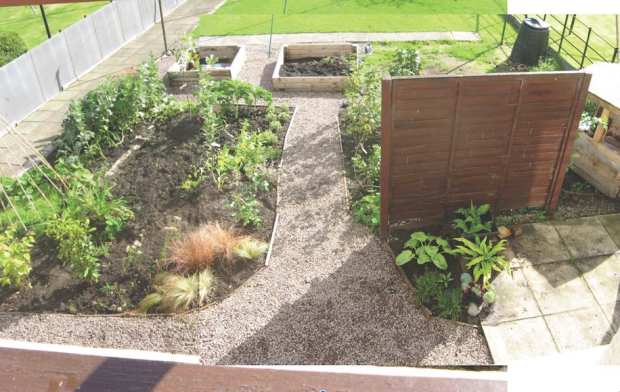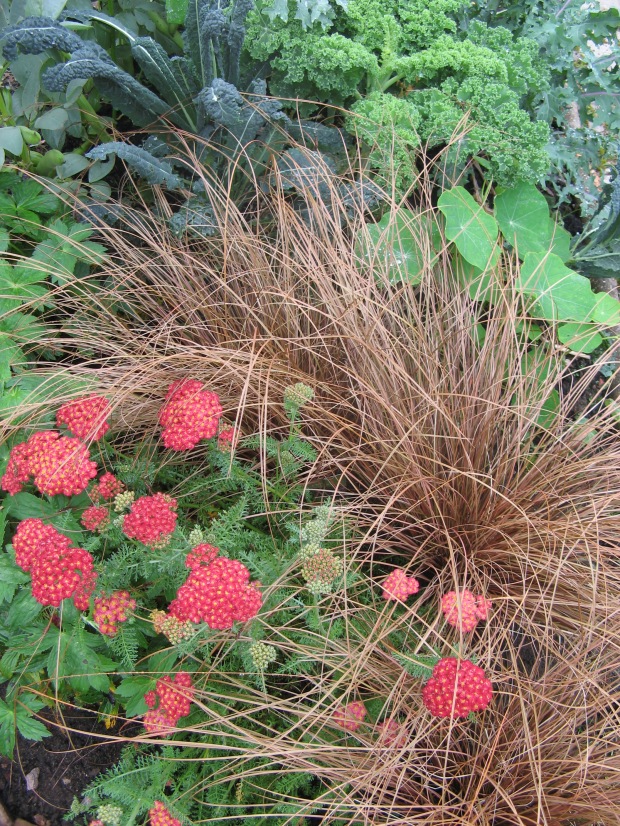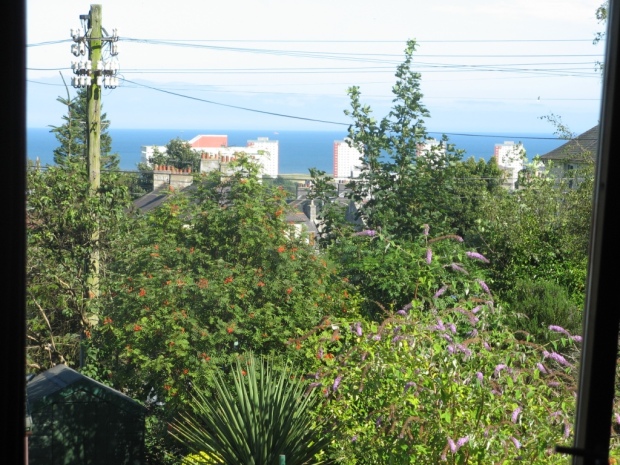Stretched out over rocks
in the river, he becomes
the mud, water, sand.
Stretched out over rocks
in the river, he becomes
the mud, water, sand.

In last week’s post I explained Challenge 1: the view of our garden from my bedroom window is weird. This challenge is primarily a design challenge that I’ll keep in mind as I make design decisions along the way. Here are the main solutions I have come up with:
Do you have any other ideas to add to the mix? I’d love to hear them. The next two challenges, which I will post over the next few weeks, are not design challenges like this one, but are also fundamental to my garden-growing process.

The only corner of my garden that feels cohesive and thriving right now. I am very happy with it! You can see in this picture: three kinds of kale, nasturtium, carex, yarrow, and a few astrantia leaves. Ooh–and I’ve just noticed some sneaky broad beans hiding in there too!
Have just listened to this great interview with Debbie Stoller on knitting and feminism. …if we went to a family function and I was wearing a dress my mom had made herself, they would say, “oh, that’s such a great dress. Can you make one for my daughter, too?” And I would get so insulted on behalf of my mother. Like, don’t these people realise that took maybe two or three weeks of evenings working to make that dress. That’s not something you ask someone “make me one of those, too”. It showed how little value and understanding there was in these kinds of skills that women had developed over centuries. (Quote comes at 17.19 min mark)
This poem is waking me up out of myself today…
He says, “up there’s a
smear of marmalade.” Even
grey days have sweetness.
 After living in our flat for just over a year now, I have become aware of the three main challenges of our garden… I am sure others will raise their heads in the future, but right now, these are the things I am trying to come to terms with. The first challenge is that THE VIEW OF MY BACK GARDEN IS WEIRD. This challenge is primarily a design challenge, while the other two (in future posts) are not.
After living in our flat for just over a year now, I have become aware of the three main challenges of our garden… I am sure others will raise their heads in the future, but right now, these are the things I am trying to come to terms with. The first challenge is that THE VIEW OF MY BACK GARDEN IS WEIRD. This challenge is primarily a design challenge, while the other two (in future posts) are not.
A rule I have heard repeatedly from the amazing Margaret Roach on garden design is to design your garden for the view from your home. It is always a good idea to look out your window at the garden and make sure it looks beautiful and makes sense from that particular perspective. I spend a lot of time washing dishes in front of the kitchen window, for example, so I would like as beautiful a view as I can get from this spot (as well as a view of my four-year-old, safe, digging in the dirt). Of course, it needs to feel good when you are actually out there, but this rule-of-thumb serves to remind us not to put the garden shed right in front of our living room window, or plant a spectacular flowering tree that attracts all kinds of observable birds in a place where we can only see it when we’re crouched beside the dog kennel with a strategically-placed mirror (just an example–we don’t have a dog… or a spectacular tree… yet).
This is all fine for my front garden, which almost feels like another room that we can look out on to. The kitchen window has one view of this garden. The other window is a large one in our living room, and at any time of day or year I like to perch on the wooden bench we have beneath it with a cup of tea. In spite of the size of the window and its proximity to the busy road, the garden, tightly bound by a 5′ hedge, allows me to feel tucked away in my own sanctuary. The view is not so much a composed one, but rather one that allows little glimpses of whatever is of interest at that time of day or year.
However, our rear garden is a different story. While we are only 18″ above the front garden’s ground level, the rear garden is about 7′ below the flat’s floor level (so almost 13′ below my eye-level). As is most often the case with these kinds of four-in-a-block flats, our garden is separated from our upstairs neighbour’s by a shared drying green. Theirs is at the end of the section and ours is closest to the flat.
And therein lies the problem. We need to be right at our bedroom window to see our garden below. I am not complaining about the view beyond that (pictured above), however–over trees and houses and on down to the sea–it’s just that just that I would like to be able to look at my garden and not feel like I am looking down at a plan of my garden. What should look like drifts of grasses and flowers look more like blobs and circles, and I can see exactly where they are planted–there are no layers revealing and concealing. Simply, there’s no mystery from the perspective of our bedroom. I imagine this is what it is like to be a very tall person looking down on the parts and pins in people’s hairdos. You can see how it is done, but don’t get to appreciate the intended effect. And here we are back to the “rule”–isn’t the intended effect to create a beautiful view to see from the window?
Have you got any ideas for how to work with this issue? Let me know! Meanwhile, I have a few solutions that I have come up and I will outline them in next Sunday’s post.
Move Your DNA has been one of my favourite books of last couple of years. One concept from it that I like to remember when I am internally complaining about having to haul water from the front garden to the back and wishing we had a tap more conveniently located is this: We are used to thinking about conveniences in terms of time-saving, but they are really movement-saving. They are things that make it so that you don’t have to move. (From this interview with Katy Bowman. Quote comes at 19.55min mark).
Still fighting a persistant strep throat infection, so I’ve been eating (actually, drinking) a lot of soft foods. I never want to see ice-cream again! This pumpkin soup made with a red kabocha+a butternut squash has been perfect.
A breathy and breath-taking poem: A Small Needful Fact.
Leaves, jet trails, scarf:
fine veils before the sun,
all glowing lanterns.
If only Bea could see this, he thought. Every day, provoked by some event or other, he regretted her absence. It wasn’t a physical yearning–that came and went, and it was at an ebb just now–but rather an uneasy awareness that a huge, complicated phase of his life was passing by, crowded with significant and deeply emotional experiences, none of which Bea was seeing, none of which she was remotely involved in. And again now: these three great shimmering veils of rain, swirling majestically across the plains towards him: they were indescribable, and he would not describe them, but seeing them would leave a mark on him, a mark that would not be left on her.
Michel Faber, The Book of Strange New Things
Sore throats all around, so a lot of thyme tea (pictured) and this tumeric tea has been drunk in our home this week.
Trying to speed up on knitting this hooded cardigan for my speedily growing baby.
This thought-provoking opinion piece has been turning over in my mind the last couple of days, especially the final sentences: It’s like we live in an upside down world. Jobs that are the most vital socially – rubbish collectors, cleaners, care givers, midwives, produce pickers – are economically valued the least.
Each day, this pigeon
bobs on my fuchsia. It does
not fly from me now.